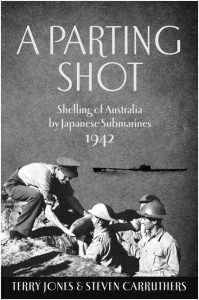- Author
- Book reviewer
- Subjects
- History - WW2, Book reviews, Naval Engagements, Operations and Capabilities
- Tags
-
- RAN Ships
- None noted.
- Publication
- June 2013 edition of the Naval Historical Review (all rights reserved)
A Parting Shot: Shelling of Australia by Japanese Submarines 1942 by Terry Jones and Steven Carruthers. Published by Casper Publications Pty Ltd, Sydney, 2013. 320 pages with illustrations and photographs. rrp $34.95. Obtainable from Dennis Jones & Associates, (03) 9762 9100

A Parting Shot, as its name implies, refers to salvos of naval gunfire from departing Japanese submarines which rained upon Sydney and Newcastle in the early hours of 8 June 1942. This occurred just a week after the Japanese midget submarine raid on Sydney Harbour. Were our major cities defenceless awaiting invasion? This well referenced volume examines the situation as seen from a civilian perspective and that of the Australian armed forces, also from what is known of Japanese operational plans.
Terry Jones is a veteran of 40 years naval service who specialised in clearance diving. As Officer-in-Charge of the RAN Clearance Diving School he had a responsibility for bomb and mine disposal. Technical input to this book is therefore well researched from someone with firsthand experience. Steven Carruthers served in the RAN specialising in anti-submarine warfare. He then pursued a career as a commercial diver before taking up a pen. His previous books include Australia Under Siege (1982) and Japanese Submarine Raiders 1942: A Maritime Mystery (2006).
Carruthers has a considerable pedigree in this subject with an excellent grasp of naval history; he is also an able author who maintains the reader’s interest.
From an historic perspective the event is significant as this was the first occasion the Australian mainland had been subjected to naval bombardment. While the damage and injury were minimal the alarm raised amongst the community was considerable. This tested emergency response systems and defence preparedness; even with primitive communications, they did better than might have been expected. The book explores how the Japanese submarine squadron of five of the largest and most highly developed vessels of this type was assigned to conduct raids on Australia’s eastern seaboard and particularly attack Sydney and Newcastle. Given that the primary role of the submarines was to sink enemy warships and secondly to interdict supply lines, with coastal bombardment an afterthought, what was achieved? The overall operation was a success in that it demonstrated the range of Japanese naval capabilities and Allied defence forces were diverted from important operations in the near north. Its achievements in the amount of damage and destruction, including the subsequent sinking of merchant ships, was possibly inconsistent with the overall expense to Japanese forces and failed in desired effectiveness.
Those enjoying further detailed descriptions will not be disappointed, the type of Japanese armament is discussed with considerable knowledge, together with the ammunition used, including their types, weight of projectiles and where and when they were manufactured. A number of urban myths are also exposed such as the exodus from the eastern suburbs and falling values of real estate.
This book expands the knowledge of Japanese wartime operations in Australian waters but the research covers a much greater depth of operations throughout the Pacific theatre. The book will be widely respected as a means of reference. It is highly recommended to the student of naval history and the general reader who wishes to know more of these times.
Reviewed by Liz Colthorpe




